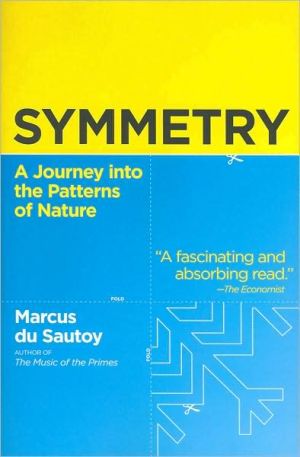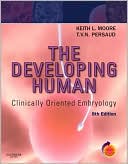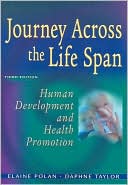Symmetry: A Journey into the Patterns of Nature
Symmetry is all around us. Our eyes and minds are drawn to symmetrical objects, from the pyramid to the pentagon. Of fundamental significance to the way we interpret the world, this unique, pervasive phenomenon indicates a dynamic relationship between objects. In chemistry and physics, the concept of symmetry explains the structure of crystals or the theory of fundamental particles; in evolutionary biology, the natural world exploits symmetry in the fight for survival; and symmetry—and the...
Search in google:
Symmetry is all around us. Our eyes and minds are drawn to symmetrical objects, from the pyramid to the pentagon. Of fundamental significance to the way we interpret the world, this unique, pervasive phenomenon indicates a dynamic relationship between objects. In chemistry and physics, the concept of symmetry explains the structure of crystals or the theory of fundamental particles; in evolutionary biology, the natural world exploits symmetry in the fight for survival; and symmetry—and the breaking of it—is central to ideas in art, architecture, and music. Combining a rich historical narrative with his own personal journey as a mathematician, Marcus du Sautoy takes a unique look into the mathematical mind as he explores deep conjectures about symmetry and brings us face-to-face with the oddball mathematicians, both past and present, who have battled to understand symmetry's elusive qualities. He explores what is perhaps the most exciting discovery to date—the summit of mathematicians' mastery in the field—the Monster, a huge snowflake that exists in 196,883-dimensional space with more symmetries than there are atoms in the sun. What is it like to solve an ancient mathematical problem in a flash of inspiration? What is it like to be shown, ten minutes later, that you've made a mistake? What is it like to see the world in mathematical terms, and what can that tell us about life itself? In Symmetry, Marcus du Sautoy investigates these questions and shows mathematical novices what it feels like to grapple with some of the most complex ideas the human mind can comprehend. The Barnes & Noble Review Mathematicians are not like the rest of us. This becomes instantly clear in Chapter 1 of Marcus du Sautoy's Symmetry, where we are introduced to his two early mentors, John Horton Conway and Simon Norton. Sautoy's admiring yet frankly boggled description of these famed savants confirms every suspicion ever levied against the breed. Norton has a hobby of memorizing train schedules and plotting out optimal routes, while Conway can rattle off from memory a 54-digit number that represents the "symmetries" of a multi-dimensional construct known as the "Monster." Thanks to du Sautoy's sharp portraits, we get to know these men and others like them, souls most at home in a Platonic realm of sheer abstraction, where mathematical concepts assume a shining, epiphanical lucidity seldom attainable from earthly objects. And yet, the miracle of du Sautoy's book is that by the end, we are affirming the essential humanity of such rarefied mathematical pursuits and identifying emotionally with these tangle-haired, mad-eyed explorers of the numerical realm. Du Sautoy moves quickly into the purely mathematical aspects of the term: "Symmetry should be thought of as something active rather than passive. A symmetry of an object is what you can do to an object to leave it essentially looking like it did before you touched it." (He returns to the natural world briefly at the climax with a discussion of symmetry in viruses.) All the abstruse implications of this definition took 2,000 years to fully unravel, one advance building on another, resulting ultimately in the Atlas of Finite Groups, a landmark publication that effectively capped exploration in the field. Cannily weaving in autobiographical details, du Sautoy conveys the allure of his chosen field but also agreeably stretches the minds of his readers, until we too can experience at least faintly the excitement that accompanies hard-won insight into the fine structure of the cosmos. --Paul DiFilippo
\ Symmetry \ A Journey into the Patterns of Nature \ \ By Marcus du Sautoy HarperCollins Publishers, Inc. \ Copyright © 2008 \ Marcus du Sautoy \ All right reserved.\ \ ISBN: 9780060789404 \ \ \ Chapter One\ August: Endings and Beginnings\ \ The universe is built on a plan the profound symmetry of which is somehow present in the inner structure of our intellect.\ Paul Valéry\ \ Midday, 26 August, the Sinai Desert\ It's my 40th birthday. It's 40 degrees. I'm covered in factor 40 sun cream, hiding in the shade of a reed shack on one side of the Red Sea. Saudi Arabia shimmers across the blue water. Out to sea, waves break where the coral cliff descends to the sea floor. The mountains of Sinai tower behind me.\ I'm not usually terribly bothered by birthdays, but for a mathematician 40 is significant—not because of arcane and fantastical numerology, but because there is a generally held belief that by 40 you have done your best work. Mathematics, it is said, is a young man's game. Now that I have spent 40 years roaming the mathematical gardens, is Sinai an ominous place to find myself, in a barren desert where an exiled nation wandered for 40 years? The Fields Medal, which is mathematics' highest accolade, is awarded only to mathematicians under the age of 40. They are distributed every four years. This time next year, the latest batch will be announced in Madrid, but I am now too old to aspire to be on the list.\ As a child, I hadn't wanted to be a mathematician at all. I'd decided at an early age that I was going to study languagesat university. This, I realized, was the secret to fulfilling my ultimate dream: to become a spy. My mum had been in the Foreign Office before she got married.\ The Diplomatic Corps in the 1960s didn't believe that motherhood was compatible with being a diplomat, so she left the Service. But according to her, they'd let her keep the little black gun that every member of the Foreign Office was required to carry. 'You never know when you might be recalled for some secret assignment overseas,' she said, enigmatically. The gun, she claimed, was hidden somewhere in our house.\ I searched high and low for the weapon, but they'd obviously been very thorough when they taught my mum the art of concealment. The only way to get my own gun was to join the Foreign Office myself and become a spy. And if I was going to look useful, I'd better be able to speak Russian.\ At school I signed up for every language possible: French, German and Latin. The BBC started running a Russian course on television. My French teacher, Mr Brown, tried to help me with it. But I could never get my mouth around saying 'hello'—zdravstvuyte—and even after eight weeks of following the course I still couldn't pronounce it. I began to despair. I was also becoming increasingly frustrated by the fact that there was no logic behind why certain foreign verbs behaved the way they did, and why certain nouns were masculine or feminine. Latin did hold out some hope, its strict grammar appealing to my emerging desire for things which were part of some consistent, logical scheme and not just apparently random associations. Or perhaps it was because the teacher always used my name for second-declension nouns: Marcus, Marce, Marcum, . . .\ One day, when I was 12, my mathematics teacher pointed at me during a class and said, 'du Sautoy, see me at the end of the lesson.' I thought I must be in trouble. I followed him outside, and when we reached the back of the maths block he took a cigar from his pocket. He explained that this is where he came to smoke at break-time. The other teachers didn't like the smoke in the common room. He lit the cigar slowly and said to me, 'I think you should find out what mathematics is really about.'\ I don't quite know even now why he singled me out from all the others in the class for this revelation. I was far from being a maths prodigy, and lots of my friends seemed just as good at the subject. But something obviously made Mr Bailson think that I might have an appetite for finding out what lay beyond the arithmetic of the classroom.\ He told me that I should read Martin Gardener's column in Scientific American. He gave me the names of a couple of books which he thought I might enjoy, including one called The Language of Mathematics, by Frank Land. The simple fact of a teacher taking a personal interest in me was enough to spur me on to investigate what it was that he found so intriguing about the subject.\ That weekend my dad and I took a trip up to Oxford, the nearest academic city to our home. A little shopfront on The Broad bore the name Blackwell's. It didn't look terribly promising, but someone had told my dad that this was the Mecca of academic bookshops. Entering the shop you realized why. Like Doctor Who's Tardis, the shop was huge once you had entered the tiny front door. Mathematics books, we were told, were down in the Norrington Room, as the basement was known.\ As we went downstairs a vast cavernous room opened up before us, stuffed full of what looked to me like every possible science book that could ever have been published. It was an Aladdin's cave of science books. We found the shelves dedicated to mathematics. While my dad searched for the books my teacher had recommended, I started pulling books off the shelves and peering inside. For some reason there seemed to be a high concentration of yellow books. But it was what I found within the yellow covers that grabbed my attention. The contents looked extraordinary. I recognized strings of Greek letters from my brief foray into learning Greek. There were storms of tiny little numbers and letters adorning x's and y's. On every page there were words in bold like Lemma and Proof.\ \ \ Continues... \ \ \ \ Excerpted from Symmetry by Marcus du Sautoy Copyright © 2008 by Marcus du Sautoy. Excerpted by permission.\ All rights reserved. No part of this excerpt may be reproduced or reprinted without permission in writing from the publisher.\ Excerpts are provided by Dial-A-Book Inc. solely for the personal use of visitors to this web site.\
August: Endings and Beginnings 1September: The Next Roll of the Dice 32October: The Palace of Symmetry 62November: Tribal Gathering 88December: Connections 113January: Impossibilities 140February: Revolution 173March: Indivisible Shapes 208April: Sounding Symmetry 243May: Exploitation 264June: Sporadic 296July: Reflections 326Further Reading 355Acknowledgements 361Picture credits 363Index 367
\ From Barnes & NobleIf you are a mathematician, you might be able to identify 196,883 as the number of dimensions possessed by the aptly named monster automorphism group. The awesome centerpiece of Griess algebra possesses more symmetries than there are atoms in the sun. Oxford professor Marcus du Sauytoy uses this example, as well as dozens of others, to illustrate the pervasive presence and fundamental usefulness of symmetries. This beautifully illustrated book will appeal to the eye as well as the mind.\ \ \ \ \ Publishers WeeklyWhen most of us think of symmetry, we think of looking into a mirror or playing patty-cake with a child. As Oxford don du Sautoy (The Music of the Primes) tells readers, this is only the tip of the triangle in the mathematical realms of symmetry, where symmetrical objects exist in dimensions far beyond our ability to imagine. The author takes readers gently by the hand and leads them elegantly through some steep and rocky terrain as he explains the various kinds of symmetry and the objects they swirl around. Du Sautoy explains how this twirling world of geometric figures has strange but marvelous connections to number theory, and how the ultimate symmetrical object, nicknamed "the Monster," is related to string theory. This book is also a memoir in which du Sautoy describes a mathematician's life and how one makes a discovery in these strange lands. He also blends in minibiographies of famous figures like Galois, who played significant roles in this field. This is mainly for science buffs, but fans of scientific biographies will also find it appealing. B&w illus. (Mar.)\ Copyright 2007 Reed Business Information\ \ \ A pilgrimage through the uncanny world of symmetry. Du Sautoy (Mathematics/Oxford; The Music of the Primes: Searching to Solve the Greatest Mystery in Mathematics, 2003, etc.) has two concerns. The first is defining the role of symmetry as a key to understanding many of nature's intimate relationships: how it reveals genetic superiority through the conspicuous display of energy required to produce such beauty; how it signals to creatures (in "a very basic, almost primeval form of communication") to go about the important business of reproduction. Du Sautoy's second concern regards the ways in which symmetry achieves economy, efficiency and stability in nature, as in the comb of a honeybee hive or in spheres like bubbles and raindrops, which place a premium on surface area relative to a given volume. The author's prose is equally economical and elegant, but when he gets going on the math behind the symmetry he enters a realm dense with equations and jargon, likely to give the math-challenged a case of the fantods: "I dive into an explanation of how I think you could use Galois's groups PSL(2, p) built from permuting lines, mixed with zeta functions to try to prove that there are infinitely many Mersenne primes . . . " Still, du Sautoy doesn't leave readers dangling; he takes pains to explain the secret language of math, even if it requires considerable backing-and-filling to keep pace with him. Impressively, he conveys the thrill of grasping the mathematics that lurk in the tile work of the Alhambra, or in palindromes, or in French mathematician Evariste Galois's discovery of the interactions between the symmetries in a group. Not for the faint of mathematical heart, but a dramaticallypresented and polished treasure of theories. Agent: Rafe Sagalyn/The Sagalyn Agency\ \ \ \ \ The Barnes & Noble ReviewMathematicians are not like the rest of us. This becomes instantly clear in Chapter 1 of Marcus du Sautoy's Symmetry, where we are introduced to his two early mentors, John Horton Conway and Simon Norton. Sautoy's admiring yet frankly boggled description of these famed savants confirms every suspicion ever levied against the breed. Norton has a hobby of memorizing train schedules and plotting out optimal routes, while Conway can rattle off from memory a 54-digit number that represents the "symmetries" of a multi-dimensional construct known as the "Monster." Thanks to du Sautoy's sharp portraits, we get to know these men and others like them, souls most at home in a Platonic realm of sheer abstraction, where mathematical concepts assume a shining, epiphanical lucidity seldom attainable from earthly objects. And yet, the miracle of du Sautoy's book is that by the end, we are affirming the essential humanity of such rarefied mathematical pursuits and identifying emotionally with these tangle-haired, mad-eyed explorers of the numerical realm. Du Sautoy moves quickly into the purely mathematical aspects of the term: "Symmetry should be thought of as something active rather than passive. A symmetry of an object is what you can do to an object to leave it essentially looking like it did before you touched it." (He returns to the natural world briefly at the climax with a discussion of symmetry in viruses.) All the abstruse implications of this definition took 2,000 years to fully unravel, one advance building on another, resulting ultimately in the Atlas of Finite Groups, a landmark publication that effectively capped exploration in the field. Cannily weaving in autobiographical details, du Sautoy conveys the allure of his chosen field but also agreeably stretches the minds of his readers, until we too can experience at least faintly the excitement that accompanies hard-won insight into the fine structure of the cosmos. --Paul DiFilippo\ \








